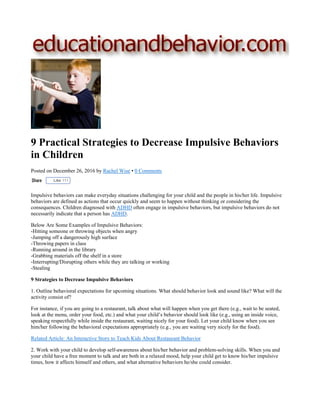
9 Practical Strategies to Decrease Impulsive Behavior in Children
- 1. 9 Practical Strategies to Decrease Impulsive Behaviors in Children Posted on December 26, 2016 by Rachel Wise • 0 Comments Like 111 Impulsive behaviors can make everyday situations challenging for your child and the people in his/her life. Impulsive behaviors are defined as actions that occur quickly and seem to happen without thinking or considering the consequences. Children diagnosed with ADHD often engage in impulsive behaviors, but impulsive behaviors do not necessarily indicate that a person has ADHD. Below Are Some Examples of Impulsive Behaviors: -Hitting someone or throwing objects when angry -Jumping off a dangerously high surface -Throwing papers in class -Running around in the library -Grabbing materials off the shelf in a store -Interrupting/Disrupting others while they are talking or working -Stealing 9 Strategies to Decrease Impulsive Behaviors 1. Outline behavioral expectations for upcoming situations. What should behavior look and sound like? What will the activity consist of? For instance, if you are going to a restaurant, talk about what will happen when you get there (e.g., wait to be seated, look at the menu, order your food, etc.) and what your child’s behavior should look like (e.g., using an inside voice, speaking respectfully while inside the restaurant, waiting nicely for your food). Let your child know when you see him/her following the behavioral expectations appropriately (e.g., you are waiting very nicely for the food). Related Article: An Interactive Story to Teach Kids About Restaurant Behavior 2. Work with your child to develop self-awareness about his/her behavior and problem-solving skills. When you and your child have a free moment to talk and are both in a relaxed mood, help your child get to know his/her impulsive times, how it affects himself and others, and what alternative behaviors he/she could consider.
- 2. Things to think/talk about when exploring self-awareness with your child as it relates to impulsive behavior: -when do you tend to act impulsively? -how does it affect you? -how does it affect others? -what can you do to ensure you don’t make impulsive decisions during your trouble spots? -how can emotions affect impulsivity? -what are some alternative ways to handle your emotions? Research suggests that children with impulsive behaviors such as those with Attention Deficit Hyperactivity Disorder and Oppositional Defiant Disorder show improvement when consistently taught pro-social behaviors such as how to conduct themselves in different situations, how to identify problems and brainstorm solutions, and how to recognize which behaviors may be undesirable in certain situations. For more on these research studies see Evidence- based Psychosocial Treatment for ADHD Children and Adolescents and Improving Treatment Outcome for Oppositional Defiant Disorder in Young Children. 3. Have your child reward him/herself with a preferred activity or item, for getting through a specific time period (e.g., dinner, school, or homework) without any impulsive behaviors (behaviors that disrupt the environment or are hurtful/inconsiderate to self or others)
- 3. 4. Encourage your child observe his/her environment to notice if he sees/hears impulsive behaviors. Talk about what the individual could have done differently. Discuss the situation and alternatives. 5. Talk about the differences between impulsive and non-impulsive behaviors/decisions. Try to visualize through real- life examples (as in the pictures below) what those differences look like. Act out, show pictures, or draw different scenarios. There are a ton of images on Google that illustrate impulsive and non-impulsive behavior. For a fun activity, ask your child to draw a picture of someone engaging in impulsive and non-impulsive behavior. 6. Children who have more down-time/unstructured time are more likely to engage in impulsive behaviors. Help your child plan his day so he knows what to do with himself. Fill it with preferred activities (playing outside, video games, coloring, music) and non-preferred activities (homework, chores, etc.). Less down time = less impulsive behaviors. Related Article: How to Use Schedules to Improve Children’s Behavior 7. Explain to your child that once you get to be an adult, impulsive behaviors are often not tolerated in the work place or community. Discuss real-life consequences, such as being fired, thrown out, or arrested, for certain types of impulsive behaviors (e.g., throwing things in a public place, hitting someone at work, etc.)
- 4. 8. Exercise. Studies show that regular exercise helps reduce anxiety, aggression, and hyperactivity, which can all put you at risk for impulsive behaviors. Related Article: How to Use Exercise to Help Kids with Autism and ADHD 9. Accept that you will not be able to make all impulsive behaviors go away. Some individuals just have somewhat of an impulsive personality and while you want to make behaviors more appropriate, you don’t want to stop someone from being themselves. Everybody can be a little impulsive at times and in certain situations it can be a good thing. Just keep in mind that if it is inconsiderate, hurtful, or disrespectful to self or others it should be addressed. Thank you for visiting educationandbehavior.com. We provide free learning, behavioral, and social-emotional support for children. Follow us on Facebook! If you found this helpful, please share it!
- 5. Related Article: Top 10 Discipline Tips for Children with Oppositional Defiant Disorder Courtesy of educationandbehavior.com